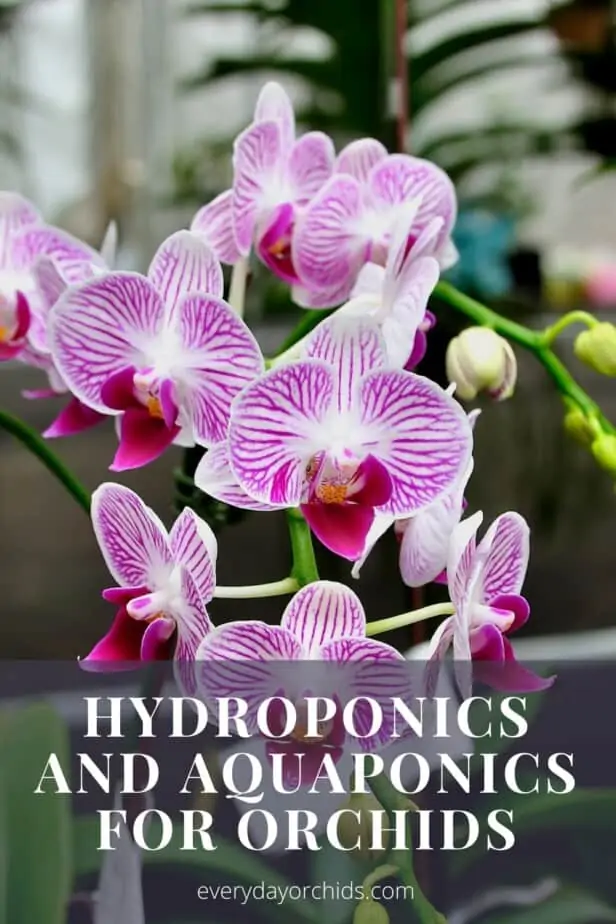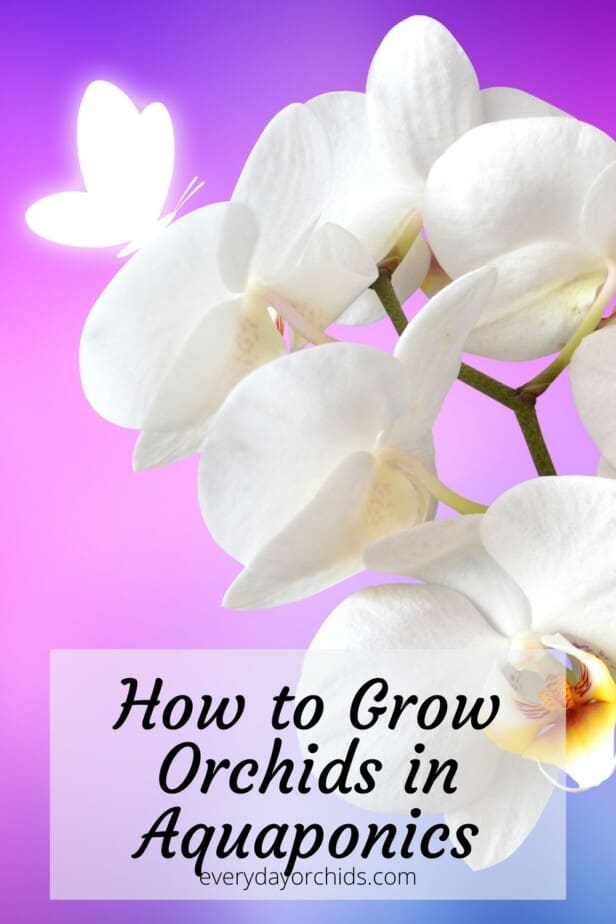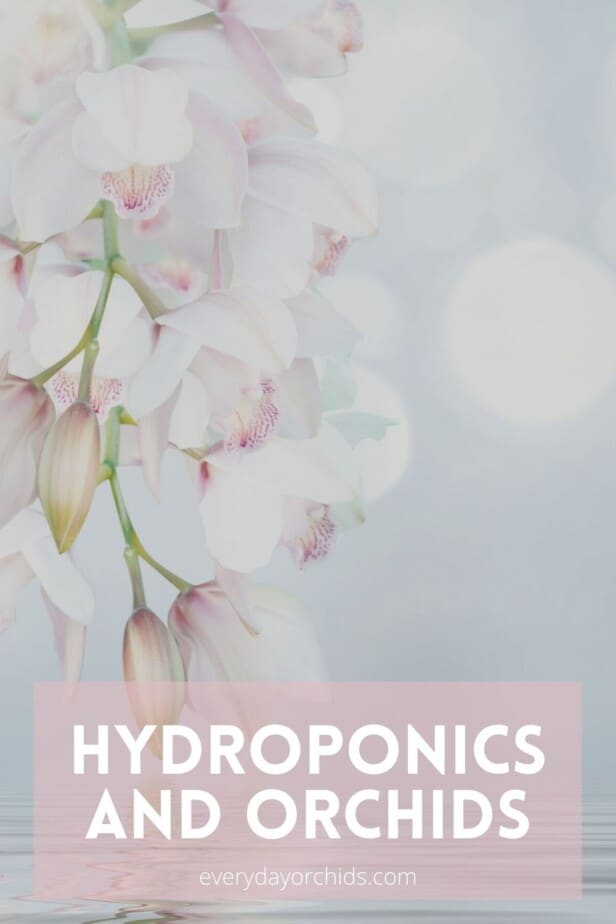Hydroponics and aquaponics are another way to grow orchids at home, but how is it done? Hydroponics, also called water culture, is a unique method for growing orchids. It is very different than the traditional orchid potting media and pot method, and involves a wicking process to draw water up to the orchid roots.
Most beginners will not start with hydroponics or aquaponics culture when growing orchids, but if you are looking for a challenge, hydroponics can be a great way to care for an orchid collection.
To grow orchids in hydroponics or aquaponics, attention to detail is required, especially with regards to the orchid’s specific needs. Generally, hydroponics involves putting your orchid in a container with just water and a wicking growing medium such as clay pebbles, perlite, or gravel. Capillary action will wick the water up to the roots. In aquaponics, you will grow orchids with fish or other aquatic animals in soil-free environments.
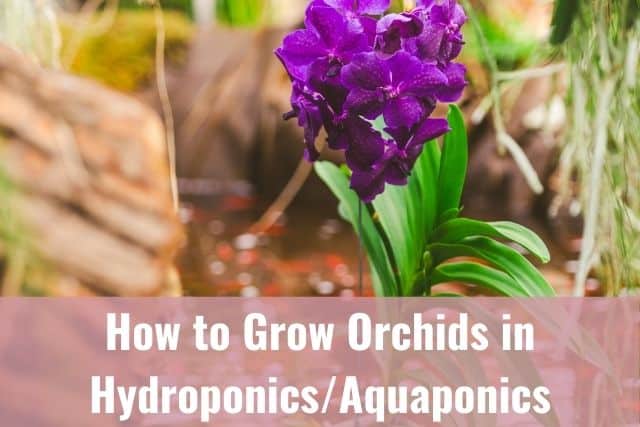
Curious to learn more about growing orchids in hydroponics or aquaponics? If so, then you are in the right place. Read on for an in-depth discussion on how to grow healthy orchids in soil-free environments.
Please note that these links are affiliate links and as an Amazon Associate, I earn from qualifying purchases. Purchases made through affiliate links in this post may generate commissions at no additional cost to you. Use this link for a discounted Amazon Prime trial. Thank you for your support!
Table of Contents
Can You Grow Orchids Without Soil?
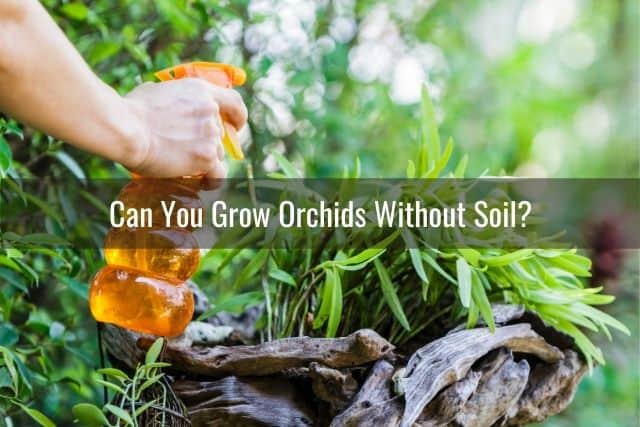
Most orchids are epiphytes, which means they prefer growing on other plants as opposed to soil. In many cases, planting your epiphytic orchid directly in potting soil will almost certainly harm its root system. Not allowing the roots to breathe will lead to root rot and the eventual death of the plant.
Orchids thrive in planting mediums such as bark and sphagnum moss. They can also thrive in controlled environments such as hydroponics.
Can You Grow Orchids in Water?
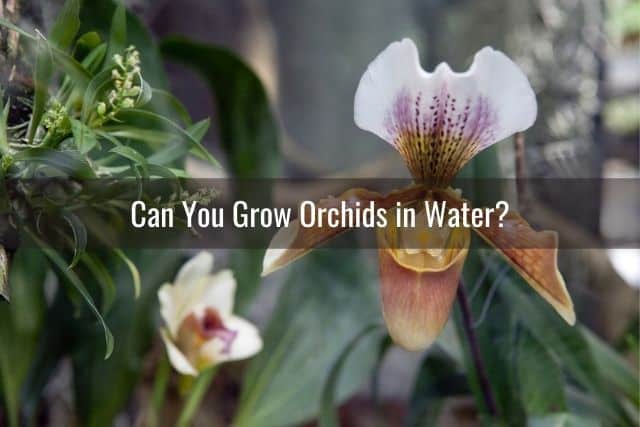
Orchids can grow in water, provided that their basic requirements are met. You will need to change the water regularly to allow for adequate air circulation and to prevent root rot. If the orchid is grown in water as the sole medium, then give the roots enough time to dry between water changes.
Orchid enthusiasts usually have varying growing techniques. Hydroponics is growing in popularity. Growing orchids hydroponically allows the plants to benefit from high humidity levels. This is necessary for the plants to grow and flower.
Can Orchids Grow in Hydroponics?
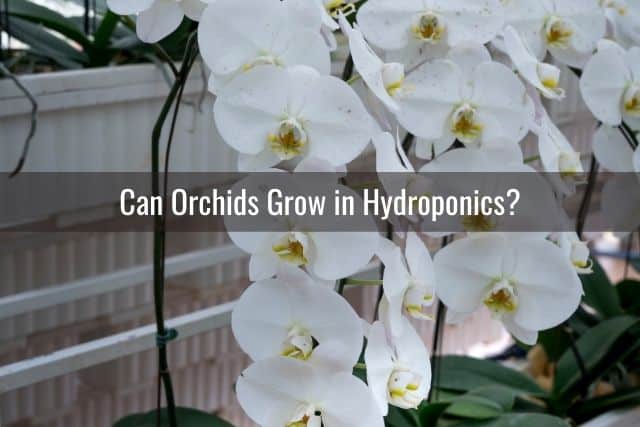
Not all orchids are suitable for the hydroponics system. For the most part, you will want to work with terrestrial orchids, not epiphyte orchids. Terrestrial orchids grow in moist, loose soil and require high moisture levels to thrive. This makes them ideal for hydroponic growing.
Therefore, you will need to be extra careful when choosing orchids, especially if you intend to grow them hydroponically. Paphiopedilum and Cypripedium varieties (slipper orchids) and Phalaenopsis (moth orchids) are examples of orchids that can thrive in a well-set-up, hydroponic system.
Hydroponic Systems Best Suited for Orchid Growth
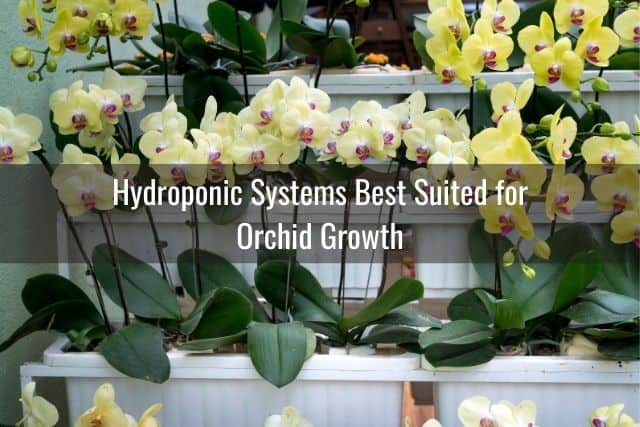
With several hydroponic systems to choose from, finding one that perfectly suits your orchid can prove problematic. For instance, a Deep Water Culture (DWC) system might not be the best option for orchids. This system tends to overexpose the orchids to water.
Another unsuitable hydroponics system is the nutrient film technique system (NFT). The NFT system works by suspending plants strategically above a stream of flowing (continuously) nutrient solution. Orchids grown as a group will be the best choice for this system. In general though, planting orchids as a group is not advisable since orchids usually have varying growth needs depending on species.
The Wick System is by far the best method to grow orchids hydroponically at home. It involves nestling the orchid in a growing media sitting above a reservoir containing water with dissolved nutrients. Wick systems are known for their simplicity. They are passive hydroponics, meaning they will not require mechanical parts such as pumps to function.
Growing Orchids Using a Wick System (Kratky Method)
If you are dealing with one, two, or even three orchids that you want to grow hydroponically, then it is best to use a wicking system. More specifically, you can use the Kratky Method. So what exactly does a Kratky Method entail?
The Kratky method is a handy hydroponic method that adds simplicity to orchid growing. The Kratky method is a passive hydroponic system that allows you to grow your orchid without electricity or pumps. You will not need to change the reservoir or add nutrients. This makes the Kratky method the best hands-off technique to grow orchids at home.
This method involves using wicking growing media to act as a capillary system. This brings water and nutrients to the orchid’s roots. Plant enthusiasts will recommend varying types of inert media. However, the most commonly used media include perlite, rock wool, charcoal, gravel, and clay pebble. Of all the inert media, hydro clay (LECA) pebbles are the most recommended due to their excellent capillary properties.
LECA Pebbles

Besides their excellent capillary properties, LECA pebbles do not decay or support the formation of mold and mildew. This has the benefit of enhancing your plant’s overall health. These pebbles contain a hard ceramic shell that promotes extra-strong capillary action. This capillary action allows for moisture and nutrients to reach the orchid’s root system.
The pebbles’ smooth outer shells are integral in reducing salt build-up. Meanwhile, their irregular shape ensures that there is great air circulation at the root level.
Hydroton Pebbles and Other Media
Hydroton expanded clay pebbles are another type of inert media. You can use these to grow orchids passively. Hydroton pebbles are semi-permeable and can be reused, provided that they are thoroughly rinsed. The main problem with Hydroton pebbles is their round, uniform shape that makes repotting a tedious process.
Perlite and vermiculite can also be used to grow orchids hydroponically. Both are clean, odorless, seed-free, insect-free, and disease-free, meaning they will not rot, decompose or deteriorate over time.
Lighting Needs for Growing Orchids Hydroponically
Most orchids need plenty of light to thrive and flower, preferably at least 8-12 hours of light a day. While most orchids can still grow without the minimum recommended amount of light, inadequate lighting prevents them from flowering to their full potential.
How to Assess Light for Orchids
When dealing with orchids, leaf color usually indicates whether the lighting is sufficient or insufficient. Excessively dark green leaves will undoubtedly enhance your orchid’s appearance, but it often signals that it needs more light.
On the other hand, a grassy green color (medium or light green with healthy yellowish tones) means your orchid is receiving adequate light. Adequate light levels are necessary for your orchid to be able to rebloom.
Here is a simple but handy way to gauge light intensity and ensure your orchid is receiving enough sunlight. Put your hand approximately 12 inches above the orchid’s leaves. Observe the shadows that are cast. No shadow means the current lighting is insufficient, and the orchid probably will not bloom. A sharp-edged shadow points to high levels of light. A soft-edged shadow indicates the lighting level is medium to low.
Grow Lights for Orchids
Sunlight might be inconsistent during the cold and wet seasons. Therefore, investing in artificial lighting, or grow lights, is highly recommended for orchids. Ideally, the bulb should give off blue light during the vegetative growth phase. Once the plant starts to flower, you should consider switching to a warmer light bulb.
Feel free to reposition the orchids to suit your display needs once they have bloomed. Once the flowers begin to wilt, return the orchids to their positions under the lighting system. Be aware that that growing orchids under intense lighting often leads to increased water usage. This is because the heat from the lights speeds up evaporation. As a result, you will need to check on water levels frequently.
Here are three great grow light options you can purchase for your orchids.
Grow Light Abonnylv Floor LED Grow Light with Stand
This 3 in 1 LED growth lamp comes with a goose-neck design that provides balanced light coverage. It provides a sun-like full spectrum of light. It can easily be adjusted to suit your orchid’s growth needs. The tripod height can be moved up or down to suit the height needs of your orchid.
The plant light is also adjustable up to 360 degrees and is easy to move. This makes it convenient for usage on orchids. It is made of 315 LED beads. It manages an impressive power of 150W, allowing it to provide uniform and strong intensity light to your orchid.
80W LED Grow Lights for Indoor Plants Full Spectrum
With four lamps and three modes, this highly capable LED grow light is ideal for growing orchids hydroponically. The red light promotes flowering in orchids. Blue light allows chlorophyll to synthesize more energy to promote root, stem, and leaf growth. The yellow light mimics sunlight and works best when the orchid is about to flower.
This lamp is easy to install. It even comes with an infrared remote control that allows you to switch between different colors and set a timer. This grow light is ideal for use on winter, autumn, and rainy days when plants are unable to access enough sunlight.
LED Grow Light for Indoor Plants 75W Sunlike Full Spectrum Indoor Grow Light
This grow light has four dimmable levels that allow you to regulate the light intensity for your orchid. Using C-clamps, you can easily use this grow light on your plant stand or hydroponics system. You can set full-spectrum lights to turn off automatically after 3, 6, or 12 hours.
The use of CREE LED chips ensures the grow light lasts long enough. Meanwhile, the highly flexible gooseneck allows you to direct the lamp to face your orchid’s direction. Moreover, the full spectrum light accelerates plant growth, in the process of shortening the growth cycle.
Advantages of Growing Orchids Hydroponically
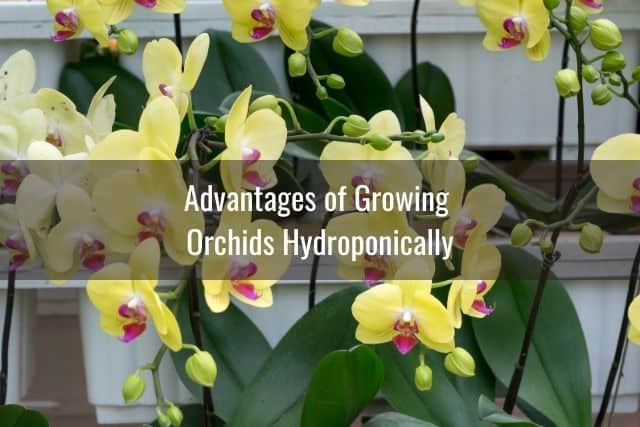
- Control over growing conditions: A hydroponics system does not use soil, meaning you can control your orchid’s growing conditions. You can control the water temperature, pH, additives, and so on. This allows you to grow orchids in different climates at any time of the year without worrying about the weather.
- Eliminates guesswork when it comes to watering: As water-sensitive plants, orchids cannot survive in either excess or too little water. Thankfully, however, hydroponics solve the problem. Most systems come packed with a water gauge that notifies you when to water and in what quantities.
- Hydroponics provide the needed humidity: Although not the most sensitive plants to grow at home, orchids have specific requirements that must be met for the plant to thrive. A hydroponics system allows your orchid to grow in a high humidity environment, which is necessary for its healthy growth.
- A hydroponics system eliminates the risk of infection: Growing orchids hydroponically eliminates the risk of bacteria and fungus infestation. Hydroponic gardening also keeps orchid pests like slugs, thrips, and aphids at bay. This enhances the chances of your orchid growing and blooming as expected.
Disadvantages of Growing Orchids Hydroponically
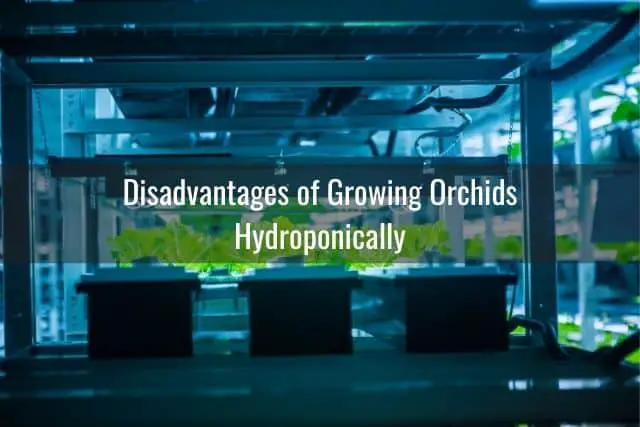
- Hydroponic growing might prove challenging: Although not rocket science, understanding how the hydroponics system works can prove taxing, especially for first-timers. You will need to understand the required nutrients, humidity, and light for your orchid to grow.
- Growing orchids hydroponically is more costly than soil planting: Setting up and maintaining a hydroponics system is not super expensive. However, depending on the type of hydroponics system you opt to use, it will cost you a lot more than planting your orchid in a pot with orchid potting media.
- A hydroponic system does not guarantee healthy orchids: Deciding to grow your orchids hydroponically does not guarantee it will grow and be free of disease or problems. You will still be required to put in a lot of work to provide the right environment for your orchid to grow. Factors such as inadequate lighting and excess water can lead to fungal infections such as Botrytis.
Can Orchids Grow in Aquaponics?

Growing orchids in aquaponics is possible, but the level of success depends on the type of orchid you have. But before I get to the basics of growing orchids in aquaponics, let’s take a quick look at what exactly is aquaponics.
Aquaponics is derived from aquaculture and hydroponics. Aquaculture can be defined as the process of breeding, rearing, and harvesting aquatic animals and plants in a highly controlled environment.
On the other hand, hydroponics refers to growing plants in water, without soil. Combine these two, and you have aquaponics, which is a system that combines plants and aquatic animals to create a symbiotic and self-sustaining growing environment.
When growing orchids in aquaponics, it is crucial to consider factors such as water type. Avoid placing your orchids in a salt water system as the salt will likely kill the orchid over time. Since aquaponic systems are similar to hydroponics, if you already have a hydroponic system set up, you can use this system and add fish to the water tanks.
pH Considerations in Aquaponics
To succeed in aquaculture, it is integral to monitor the pH levels. You will likely need to invest in a pH monitor such as this one. Determining the right pH levels can be daunting, especially since you will need to factor in the unique needs of each organism in your aquaponics system. Maintaining a neutral pH of around 6.8 to 7.2 should work well for both plants and fish in the system.
The presence of fish waste will turn the pH slightly acidic. You will need to use pH adjusters that are compatible with your aquaponic system. Remember to keep the pH levels within the acceptable limits (not too high or low). Extreme pH levels will prevent the orchids from absorbing nutrients and can even kill your fish.
The types of fish you introduce in your aquaponics system also plays a huge role in determining whether your orchids will thrive and bloom. Ideally, freshwater fish like barramundi and tilapia works best for aquaponics systems. Besides growing quickly, these two types of fish are known to tolerate diverse water conditions.
Please note that you will need to regularly feed the fish, especially as they are growing, promoting good health. Giving your fish high-quality food means your orchids will also benefit. The orchids will feed off the nutrients from the waste of your fish. You can also add snails and shrimps to your aquaponic system if you fancy having them as part of your aquarium ecosystem.
Advantages of Growing Orchids in Aquaponics
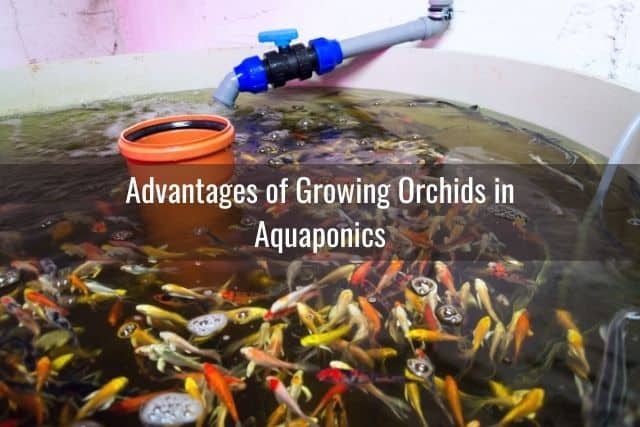
- Aquaponics eliminates the need to dissolve nutrients in water: With aquaponics, you no longer have to worry about buying fertilizers or nutrients to dissolve in water for your orchid. All you will need to do is feed your fish, and you are good to go. The waste produced by your fish will provide enough nutrients to support your plant’s growth and bloom.
- Promotes rapid orchid growth: Since, similar to hydroponics, you will be growing your orchids in a controlled environment, they are likely to grow faster as they will receive the necessary requirements for growth. You will only need to examine the internal environment on a regular basis to ensure it stays conducive for both the orchid and your aquatic animal.
- Aquaponics eliminates the need for chemicals or pesticides: Aquaponics plays a huge role in promoting healthy plant development. Since aquaponics entails breeding fish, using chemicals and pesticides is completely out of the question. Otherwise, you will kill your fish.
- Eliminates the risk of soil-borne diseases: Aquaponics combines aquaculture and hydroponics, allowing you to grow your orchid in controlled environments without the risk of soil-related diseases. The active flow of water also minimizes the chance that organisms like mold and other types of bacteria from breeding in the ecosystem.
- The controlled aquaponic environment is suitable for orchid growth: An aquaponics system ensures your orchid never lacks the required amount of water and that the humidity levels are as desired. You can easily control the lighting to promote the growth and flowering of your orchid.
Disadvantages of Growing Orchids in Aquaponics

- Aquaponics might be hard for beginners: If you are just starting out as an orchid grower, chances are aquaponics might prove too complex at first.
- Inconsistent mealtimes might affect orchid growth: In aquaponics, you will need to feed the fish regularly with high-quality foods since your orchids rely on the waste for nutrition. Failure to feed your fish consistently means your plants might end up lacking the required nutrients.
- Maintenance can prove problematic: Setting up and maintaining an aquaponics system is not as straightforward as most people perceive. You will need to constantly check the pH levels, examine the water quality, and also the overall health of your fish. You might end up changing the entire system if the current setup does not work well for your plants.
Final Thoughts
Orchids are great plants to own and care for. The first step in growing orchids in hydroponics or aquaponics is identifying the orchid species you are dealing with. This is because orchids come in a variety of species, each with its specific requirements and some may not be suitable for aquaponic gardening.
In hydroponics, it is highly advisable to use a water gauge to determine when to add water for your orchid or change the water. If you opt for aquaponics, pay extra attention to the pH, as too high or too low of a pH level might affect both your orchid and fish.
Above all, whatever method you use, have fun growing your orchids!
If you enjoyed this article, please pin it and share!
